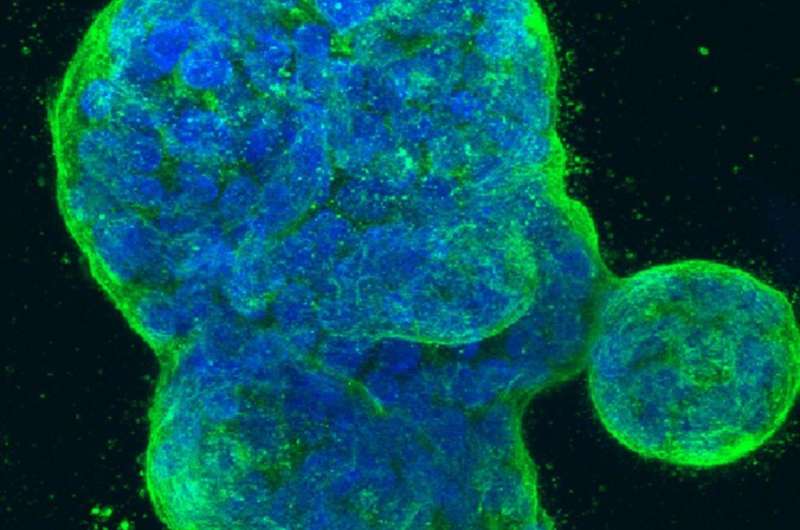Three-dimensional culture of human breast cancer cells, with DNA stained blue and a protein in the cell surface membrane stained green. Image created in 2014 by Tom Misteli, Ph.D., and Karen Meaburn, Ph.D. at the NIH IRP.
Women who are diagnosed with ductal carcinoma in situ (known as DCIS) during breast screening go on to experience higher risks of developing breast cancer and of death from breast cancer, compared with the general population, finds a study published by The BMJ today.
DCIS is a disease where malignant breast cells are found but have not spread beyond the milk ducts.
The risks were more than double those of the general population, even for women diagnosed with low or intermediate grade DCIS, and lasted until at least 20 years after diagnosis, say the researchers.
Diagnoses of DCIS have increased substantially in recent years, especially among women attending breast screening programmes.
DCIS isn't immediately life-threatening and does usually have a good prognosis. But it can increase the risk of developing an invasive breast cancer later on. The extent of this extra risk is uncertain.
So researchers at the Nuffield Department of Population Health in the University of Oxford and Public Health England set out to evaluate the long term risks of invasive breast cancer and of death from breast cancer after DCIS diagnosed through breast screening.
Their findings are based on data from 35,024 women in England diagnosed as having DCIS by the NHS Breast Screening Programme from its start in 1988 until March 2014.
They compared rates of invasive breast cancer and of death from breast cancer with the corresponding national rates for women of the same age in the same calendar year.
They found that by December 2014, 2,076 women had developed invasive breast cancer, an incidence rate of 8.82 per 1,000 per year and more than double the number expected from national rates.
In the same group of women, 310 died from breast cancer, a death rate of 1.26 per 1,000 per year and 70% more than expected from national rates.
For both invasive breast cancer and death from breast cancer, the increases continued for at least two decades.
The results also suggest that women who had more intensive treatment, such as a mastectomy, had a lower long term risk of invasive breast cancer than those who had breast conserving surgery, even when radiotherapy was given.
The researchers point out that, at the moment, surveillance of women after a diagnosis of DCIS focuses just on the first few years. In the UK, for example, most women are recalled for yearly surveillance mammograms for five years, after which further follow-up is every three years via the national screening programme up to age 70 years.
"We have, however, provided evidence of the long term nature of the risk of invasive disease after a diagnosis of DCIS, even for women with low or intermediate grade disease," they write.
Further studies are needed to build on these findings, in particular to try to work out which type of DCIS is most closely linked to the development of invasive breast cancer. This may have implications for follow-up and the frequency of surveillance imaging, they conclude.
More information: Invasive breast cancer and breast cancer mortality after ductal carcinoma in situ in women attending for breast screening in England, 1988-2014, BMJ (2020). DOI: 10.1136/bmj.m1570
Journal information: British Medical Journal (BMJ)
Provided by British Medical Journal






















